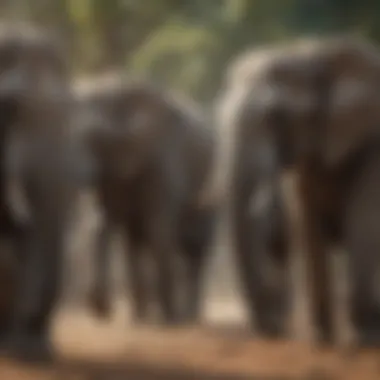The Matriarchal Structure of Elephant Societies


Intro
Elephant societies are fascinating examples of matriarchal structures in the animal kingdom. Understanding their social dynamics can provide valuable insights into their behavior and group survival strategies. This section sets the stage for a comprehensive exploration of the unique relationships and roles within elephant herds, particularly the pivotal position of matriarchs.
The matriarch, typically the oldest and most experienced female, is crucial in leading her family group. Matriarchs guide the herd in finding food, water, and safe passage during migrations. Their vast knowledge is essential, especially in changing environments where resources may become scarce.
This article will delve into the intricacies of elephant communication, how matriarchs influence social interactions, and the implications of these structures on conservation efforts. Notably, we will also consider how external factors, like climate change, affect these hierarchical systems.
By examining these aspects, we can better appreciate not just the complexity of elephant societies, but also the importance of preserving their natural habitats to ensure their survival.
Prolusion to Elephant Social Structures
Understanding elephant social structures is paramount for anyone seeking to grasp the intricacies of these magnificent creatures. Social structures not only define the interaction patterns within herds but also provide key insights into their survival strategies. Elephants exhibit complex social behaviors, and at the center of these behaviors lies the matriarch, an experienced female who shapes the dynamics of the herd. This section delves into the significance of these social frameworks, illustrating how they contribute to the elephants' overall well-being, decision-making processes, and their ability to adapt to environmental changes.
Understanding Matriarchy
The matriarchy in elephant societies is a testament to the critical role of female leadership. Elephants are highly social animals, and their survival hinges on the matriarch's ability to lead and protect her family. Matriarchs are typically the oldest females, possessing a wealth of experience. This knowledge is vital in navigating the landscape, locating water sources, and recognizing migratory paths. Their leadership style is characterized by unique characteristics such as empathy, communication, and an inherent understanding of social dynamics within the herd.
Research shows that matriarchs influence not just daily activities but also long-term survival strategies. Their decisions impact group cohesion and the emotional health of the members. For instance, a matriarch’s ability to manage conflicts and maintain relationships among females is essential for the stability of the herd. Such skills ensure that the younger members learn appropriate social behaviors, reinforcing strong family bonds over generations.
Overview of Elephant Species
Not all elephant species display the same social structures, but they share common traits. The African bush elephant and the Asian elephant are the two primary species studied in terms of matriarchal societies. The African bush elephants are known for their larger groups and more complex social networks, whereas Asian elephants, although also matriarchal, tend to form smaller family units.
Cultural variations exist within these species, influenced by environmental factors, local habitats, and human interactions. For example, in some regions, elephants adapt their social behavior to avoid human conflict, significantly affecting their traditional matriarchal communities. Understanding these differences is essential for conservation efforts, as protecting the matriarchs and their social structures can enhance the survival fitness of their herds.
"The matriarch is not just a leader; she is a lifeline to the family, guiding them through challenges with wisdom and instinct."
Role of the Matriarch
The matriarch holds a pivotal role within elephant societies that extends beyond mere familial bonds. Her presence is central to the survival and welfare of the herd, with several reasons underscoring her importance. Not only does she act as a leader, but she also embodies the collective knowledge and wisdom acquired over decades. This ensures that her group navigates their environment adeptly, ultimately enhancing their chances of survival.
In essence, designated leadership of a matriarch enables the herd to respond more effectively to threats, such as predators and environmental stressors. This established hierarchy fosters stability within the group, allowing younger elephants to learn from her experiences. The matriarch's status as the primary decision-maker significantly influences the behavior and decisions of her family members.
Leadership Characteristics
Matriarchs exhibit distinct leadership traits that are essential for effective management of their herds. These characteristics include:
- Experience: A matriarch typically leads the group after many years of life experience. This extensive history contributes to her understanding of migration paths, water sources, and feeding grounds.
- Adaptability: Matriarchs are often required to adjust strategies based on changing environmental conditions. Their ability to navigate these shifts is crucial for herd survival.
- Empathy: A strong emotional connection between the matriarch and her kin allows her to understand their needs. This empathy is paramount when caring for calves and managing the dynamics of the group.
The significance of these leadership qualities cannot be overstated. Matriarchs guide their groups through challenges, benefiting from exhaustive knowledge that is shared through generations.
Decision Making and Navigation
The decision-making process of a matriarch is a contemplative endeavor. Her capacity to make choices impacts not only daily activities but also long-term survival strategies. Key elements include:
- Social Trust: The culture of trust that exists within the herd allows matriarchs to make decisions that are often accepted without dissent. Elephants closely observe her actions, following her lead.
- Knowledge Transfer: Matriarchs often teach younger members about vital resources, like where to find water during droughts or the best feeding areas. This learning is essential during migration and adaptation to changing habitats.
- Pathfinding: Navigation is another critical aspect of her role. The matriarch frequently leads the herd on seasonal migrations, utilizing her memory of routes cultivated over the years. Her navigation skills help minimize risks during travel.
"The matriarch is not just a leader, but a guardian of knowledge that ensures future generations thrive."
In summary, the role of the matriarch transcends leadership; it encompasses vast responsibility for both immediate concerns and long-term survival strategies of the herd. Her abilities ensure continuity within these matriarchal structures, thus promoting resilience in the face of environmental challenges.
Social Dynamics within Packs
Understanding social dynamics within elephant packs is crucial. These relationships significantly impact the stability, survival, and cohesion of herds. Elephants live in matriarchal societies, where communication and emotional bonds play vital roles. Each member's actions influence the group's dynamics and can determine their success in various situations, such as foraging, predator avoidance, and nurturing offspring.
Inter-female Relationships
Inter-female relationships are foundational to the social structure of elephant herds. These relationships often stretch back over decades. Matriarchs and related females usually maintain strong social ties. This promotes cooperative behaviors, which are essential for raising young and protecting the herd.


Females share responsibility in nurturing calves. They support one another in safeguarding their young from predators. This cooperative childcare environment helps in the learning process. Calves observe and imitate their mothers and other related females, ensuring they acquire survival skills. Research has shown that in healthy herds, females are more likely to remain connected to their natal families.
Such relationships also extend beyond simple caregiving. Elephants engage in complex social behaviors, including grooming and vocal communications, which reinforce bonds. The emotional connection females share is evident. They use vocalizations to comfort one another during stressful times, indicating a deep emotional intelligence.
"The intricate web of inter-female relationships is vital for herd dynamics, offering stability and continuity."
Mother-Offspring Bonds
Mother-offspring bonds in elephants are among the most intense in the animal kingdom. These bonds are characterized by strong emotional attachment. A mother elephant invests significant time and energy raising her calf.
The mother typically stays with her calf for many years, teaching it how to navigate their habitat and connect with its social group. This learning process is vital, as it influences the calf's future interactions within the herd and with other males.
During the early years, a young elephant relies heavily on its mother for sustenance and protection. In many cases, sisters or aunts are also very involved. They often join in caregiving efforts, further enhancing the calf's social skill development. As offspring grow, they continue to maintain close ties with their mothers, often returning for guidance in critical situations.
This bond results in a social structure where generations coexist and share knowledge. Such a framework is essential during times of environmental stress, where learned survival strategies from matriarchs become crucial. Female elephants convey knowledge about food sources and water, conducted through years of experience, ensuring the survival of the younger generation.
Understanding these social dynamics can provide insights into the broader implications for elephant conservation. Protecting matriarchal structures and the relationships within herds is not just about safeguarding a species. It is about preserving the intricate social networks crucial to their survival.
Communication in Elephant Herds
Effective communication among elephants is vital for maintaining social structures and ensuring survival within their matriarchal societies. Continuous interaction through vocalizations, body language, and tactile gestures facilitates strong bonds among herd members. This intricate web of communication not only supports individual relationships but also plays a crucial role in how matriarchs guide and protect their families. Understanding these communication methods illuminates the complex dynamics present within elephant herds, creating a framework for better insights into their behavior and ecological roles.
Vocalizations and Sounds
Elephants produce a diverse array of vocalizations, each serving specific functions within their complex social framework. Vocalizations can be categorized into several types, including trumpets, rumbles, and barks.
- Trumpets: These loud calls often signal excitement or distress, alerting other members of the herd to potential threats or changes in environment.
- Rumbles: At lower frequencies, rumbles can travel long distances and are employed for maintaining contact with distant herd members. Rumbles also convey a range of emotions, including reassurance or discomfort.
- Barks and other short sounds: Used for sudden alerts, these brief vocalizations communicate immediate needs or concerns.
In addition to these vocalizations, elephants are known to produce infrasound, sounds below 20 Hz that are inaudible to humans. These low-frequency calls allow elephants to communicate over vast distances, enhancing cohesion across herds that may be separated by several kilometers. Research suggests that this method of communication is crucial for coordinating movements and social behaviors, particularly in large groups, enhancing the effectiveness of matriarchal leadership.
Non-verbal Communication
Non-verbal communication is equally significant in elephant interactions. Body posture, facial expressions, and tactile interactions convey a wealth of information. Elephants exhibit a range of behaviors that articulate their intentions and emotions, enriching their social ties.
- Body Posture: An elephant standing tall with ears spread wide may display confidence or excitement, while a smaller, hunched figure could indicate submission or fear.
- Facial Expressions: Elephants use their trunk and eyes to signal their mood or intentions. For example, a trunk raised high can indicate curiosity or a greeting. Facial wrinkling can reflect distress or irritation.
- Tactile Interactions: Physical touch through trunk-to-trunk contact reinforces bonds between individuals. Mothers often use their trunks to reassure their calves, strengthening these bonds through gentle caresses.
Communication among elephants is a critical aspect of their social structure. It allows matriarchs to maintain herd cohesion, guide movements, and ensure the wellbeing of each member. Without effective communication, hierarchies would struggle, and family units could disintegrate, leading to potential risks for survival.
"Elephants are known for their strong familial bonds, which are maintained through various forms of communication."
Reproductive Strategies
Reproductive strategies play a crucial role in the survival and continuity of elephant societies. Understanding how these strategies function offers insights into the social dynamics and overall health of elephant populations. In matriarchal structures, these strategies are often influenced by the matriarch's knowledge and experience. This section will delve into the intricacies of breeding hierarchies and the role of female choice, highlighting the significance of these elements in the context of elephant societies.
Breeding Hierarchies
Breeding hierarchies within elephant herds are generally established around the matriarch. She usually selects dominant female relatives for breeding. This hierarchy ensures that genetic diversity is maintained while allowing for the strongest offspring to be produced.
Key points include:
- Dominance Relationships: Female elephants tend to have clear dominance relationships that affect their access to resources and mates. Lower-ranking females may have reduced mating opportunities, which can impact their reproductive success.
- Genetic Diversity: By controlling breeding within the matriarchal structure, elephants ensure a wider genetic pool. This is important for resilience against diseases and environmental changes.
- Importance of Age: Often, older females possess greater wisdom in selecting optimal mates, leading to a more advantageous breeding scenario for their offspring.
"Matriarchs utilize accumulated knowledge to enhance the breeding success of their herds, emphasizing the importance of experience in this delicate process."
The Role of Female Choice
Female choice is another vital aspect that influences reproductive success in elephant herds. Female elephants show preferences that can shape the genetic outcomes of future generations. This choice is often based on several factors, such as a male's physical condition, strength, and social standing.
Important considerations include:
- Mate Selection: Females assess potential mates before engaging in mating activities. They evaluate traits like size, stamina, and social interactions. Stronger males tend to be favored, which can lead to healthier offspring.
- Social Bonds: Female elephants often choose mates from males they have established bonds with. These relationships can affect their comfort levels during mating, making female choice highly influenced by social dynamics.
- Reproductive Timing: Female elephants exhibit cyclic reproductive patterns. Timing can also affect mate selection, as certain males may be more dominant during specific periods, hence influencing female preferences.


The interplay between breeding hierarchies and female choice reveals how matriarchs mold reproductive strategies to benefit their herd's longevity and adaptability. Understanding these strategies is essential for conservation efforts, as it emphasizes the need to protect the matriarchs who shape the future of elephant populations.
Environmental Influences on Matriarchal Roles
The examination of environmental influences on matriarchal roles is vital in understanding the adaptability and functionality of elephant societies. In the context of matriarchal structures, these environmental factors can significantly affect the matriarch's ability to lead and ensure the well-being of her herd. The matriarch's role is not just about interpersonal dynamics; it also involves responding to the larger ecosystems and climatic patterns that influence resource availability and habitat integrity.
Impact of Climate Change
Climate change poses a grave threat to the habitats of elephants. As temperatures rise and weather patterns shift, elephants face increasingly challenging conditions. Changes in rainfall patterns can affect the availability of food and water resources. Matriarchs, who must navigate these challenges, play a crucial role in finding new foraging grounds. They rely on their experience to lead their herds to areas that can sustain them, reflecting a deep understanding of the environment.
- Increased temperatures can drive elephants to seek cooler areas, potentially leading to conflicts with human settlements.
- Droughts may reduce vegetation, forcing matriarchs to alter their migratory routes.
- Altered precipitation patterns can affect the availability of waterholes, which are critical for survival.
These climatic challenges necessitate resilience and adaptability in matriarchs, whose knowledge is essential for the herd's survival. Without the wisdom of experienced leaders, younger elephants may struggle to cope with changing circumstances, placing the herd at risk.
Human-Wildlife Conflict
Human-wildlife conflicts present another major environmental factor influencing matriarchal roles. As human populations expand, elephants often venture into agricultural or inhabited areas seeking food or water. Matriarchs find themselves navigating these complex situations, where their decisions can have immediate consequences for their herd's safety.
- Conflicts often arise from competition for resources, leading to property damage and safety issues.
- Matriarchs must assess risks and decide when to approach human settlements for resources, balancing the need for sustenance against the potential danger.
- Their leadership can therefore influence the herd's long-term relationship with surrounding human communities.
Understanding these interactions is imperative. The decisions that matriarchs make, influenced by increasing human encroachment, can lead to either positive coexistence or detrimental outcomes for both elephants and local populations. Conservation efforts that address these conflicts are essential to maintain the integrity of matriarchal roles in elephant societies.
"The fate of elephant herds hinges largely on the ability of matriarchs to adapt to rapidly changing environments, influenced both by climate and human activity."
Conservation and the Future of Matriarchal Elephants
The urgent need for conservation initiatives focused on matriarchal elephants is crucial for maintaining the health of elephant populations. As apex social structures, matriarchs influence the survival and dynamics of entire herds. Protecting these key individuals is not just about preserving a unique social characteristic but about ensuring the continuity of cultural transmission and social memory embedded within groups. The knowledge that matriarchs possess—ranging from migration routes to survival techniques in difficult times—is invaluable.
Weather changes, habitat loss, and poaching pose significant threats. The protection of matriarchs will safeguard the intricate social structures that are pivotal to elephants’ survival. Conserving these leaders promotes the resilience of herds, helping them to navigate challenges posed by human encroachment and changing environments.
Importance of Protecting Matriarchs
Matriarchs serve as the backbone of elephant herds. Their leadership is marked by experience, wisdom, and the ability to make crucial decisions. The influence of a matriarch extends to various facets of herd life. This includes:
- Social cohesion: Matriarchs help maintain relationships within the herd, ensuring harmony and reducing conflict.
- Knowledge transmission: They pass on vital information to younger elephants, aiding in their development and survival.
- Resource management: When it comes to finding water or food, matriarchs lead the way, showcasing their skills at remembering locations that are critical for survival.
Failing to protect matriarchs results in a knowledge gap within herds, which may lead to weaker social structures. This absence can manifest as increased mortality rates, as younger herds may struggle without experienced guidance.
Strategies for Conservation
Conservation strategies for matriarchal elephants require a multi-faceted approach, integrating local communities, researchers, and international policies. Some effective techniques include:
- Community-based conservation programs: Engaging local communities in conservation efforts ensures that they can coexist with elephant populations. This can include education on the importance of matriarchs.
- Anti-poaching efforts: Strengthening the measures against poaching will help protect these integral animals from threats that could disrupt their social structures.
- Habitat preservation: Maintaining the natural habitats where elephants reside ensures that matriarchs can continue to lead their herds effectively.
- Research funding: Allocating resources for research on elephant behavior and societal structures helps inform conservation strategies based on scientific evidence.
Protecting matriarchs is not merely a measure for conserving a species; it is an investment in the ecological legacy and social systems that sustain elephant populations.
By implementing targeted strategies aimed at preserving matriarchs, conservationists can help ensure the survival of elephants while respecting and maintaining their unique social structures. As we delve deeper into ethical considerations in human-elephant interactions, the role of conservation in shaping the future of these intelligent animals cannot be overstated.
Field Studies and Research
- Understanding Behavior: Field studies provide a direct view of elephant interactions. Observing matriarchs in action offers clarity on their role and influence within the herd.
- Capturing Social Dynamics: Every elephant herd operates differently. Long-term observation allows researchers to see how relationships among females, and between mothers and their calves, evolve over time.
- Impacting Conservation Efforts: Data from these studies can inform conservation strategies. Understanding how matriarchal roles are affected by environmental changes helps in crafting more effective protective measures for elephants.
In addition to direct observations, researchers often analyze behavioral patterns through various methodologies. These can include passive observation, where researchers note the behaviors without interfering, or active tracking, using technology to gather data. Both methods can yield rich data that highlight the urgency of protecting these social structures.
Longitudinal Studies on Elephant Behavior
Longitudinal studies are a vital aspect of understanding elephant behavior, especially in a matriarchal context. By studying the same group of elephants over extended periods, researchers can document changes in behavior and social structure that occur naturally as the herd evolves. Such studies reveal critical patterns:
- Life Stages and Roles: Observations from birth through maturity highlight how roles within the herd, particularly for matriarchs, shift as elephants age.
- Population Dynamics: By monitoring female-led herds, researchers can learn how population pressures and environmental challenges shape social interactions.
- Reproductive Success: Tracking breeding behaviors and offspring survival rates under the guidance of matriarchs provides insights into the effectiveness of matriarchal leadership.
These findings emphasize the significance of matriarchal roles in ensuring the survival of their families. Connecting these behaviors to conservation initiatives further illustrates the importance of these long-term studies.


Technological Advances in Tracking
Technological advances have revolutionized the way researchers study elephant behavior, particularly in matriarchal societies. Technologies such as GPS collars, camera traps, and drone surveillance allow for increased accuracy and depth in research. The benefits of these tools include:
- Real-Time Data Collection: GPS collars enable continuous monitoring of movement patterns. This information helps researchers identify migration routes and habitat use, crucial for understanding the influence of matriarchs.
- Behavioral Analysis: Camera traps provide visual data on herd interactions and behaviors that might not be easily observed during traditional study methods. This visual tracking can highlight social structures among matriarchs and their family members.
- Less Disruption: Advanced tracking technology minimizes human interference in natural lion behaviors. This leads to more reliable observations of natural interactions.
Cultural Perspectives on Elephants
Cultural perspectives on elephants provide valuable insights into how these majestic creatures are revered and represented across various societies. Understanding these perspectives is crucial in comprehending the broader implications of human-elephant relationships. Elephants hold significant cultural weight in many traditions, embodying values such as strength, wisdom, and loyalty. As we explore these perspectives, it is important to examine their influence on conservation efforts, ethical considerations, and the efficacy of human interaction with elephants.
Elephants in Mythology and Folklore
Throughout history, elephants have featured prominently in mythology and folklore. In Hindu culture, for example, Ganesha, the elephant-headed god, symbolizes wisdom and new beginnings. This representation not only reflects the admiration for elephants but also establishes them as a symbol of spiritual significance.
Similarly, in African folklore, elephants are often depicted as protectors or as embodiments of the ancestors' strength. Their roles in stories offer a lens through which communities understand their connection to the natural world. These narratives emphasize the need to respect these animals and ensure their survival.
- Elephants as symbols of strength
- Depictions in religious contexts
- Representations as guardians of wisdom
The cultural significance of elephants also manifests in festivals and rituals. For instance, the Thai tradition celebrates elephant parades, showcasing how people honor and appreciate their contributions to culture and heritage. Such events remind society of their responsibility towards the conservation of these animals.
The Human Connection to Elephants
The relationship between humans and elephants goes beyond mere coexistence; it embodies a complex tapestry of interdependence and mutual respect. Many indigenous communities view elephants as integral members of their ecosystem, recognizing the role they play in maintaining the balance of their environments.
Moreover, these connections are reflected in various forms of art and literature. Paintings, sculptures, and even academic texts often highlight the deep emotional bond humans share with elephants. This connection can foster empathy and understanding, crucial for effective conservation strategies.
- Appreciation of elephants in artistic forms
- Emotional ties and animal welfare considerations
- Educational initiatives promoting awareness
The intricate ties between humans and elephants emphasize the need for ethical approaches in wildlife conservation, fostering a culture of respect and preservation.
Ultimately, exploring cultural perspectives on elephants highlights the importance of nurturing these relationships. They inform conservation policies and offer cultural justifications for protecting these intelligent beings. Acknowledging their significance in human culture can augment conservation efforts, ensuring these creatures continue to thrive for generations to come.
Ethical Considerations in Human-Elephant Interactions
Ethical considerations in human-elephant interactions are increasingly important in the discussion of elephant societies, especially as humans continue to encroach on their habitats. Understanding the deep-seated traditions and behaviors of elephants provides insights into how humans should engage with these magnificent creatures. There are several key elements that reflect the weight of this topic:
- Respecting Their Social Structures: Elephant herds operate under sophisticated matriarchal hierarchies. When humans intervene, whether through tourism or conservation efforts, it is crucial to recognize and respect these structures. Disrupting the matriarch can lead to instability, affecting the entire herd's dynamics.
- Minimizing Human Impact: Ethical interactions necessitate a commitment to reducing the negative impact humans have on elephants. This includes minimizing disturbances from tourism and ensuring that any form of observation does not interfere with their natural behaviors.
- Preserving Natural Habitats: Protecting the ecosystems where elephants live is a significant ethical responsibility. This extends beyond direct interactions, requiring sustainable development strategies that do not compromise their habitats.
"Ethical considerations should guide our presence around elephant populations to ensure their welfare and the preservation of their natural behaviors."
Wildlife Tourism and Its Implications
Wildlife tourism presents both opportunities and challenges for elephant societies. On one hand, it can generate revenue for conservation and foster awareness about these animals. On the other hand, it can lead to undue stress on elephant herds.
- Pros:
- Cons:
- Funding for Conservation: Revenues from tourism can support elephant conservation initiatives, offering financial resources necessary for habitat protection.
- Education and Awareness: Engaging with tourists can help spread awareness about the plight of elephants, potentially increasing public support for conservation efforts.
- Disruption of Natural Behaviors: Close proximity to tourists may alter normal behaviors, causing stress and anxiety among elephants.
- Safety Risks: Some forms of tourism may put both elephants and humans at risk if not carefully managed.
Captivity and Welfare Issues
The ethical considerations around elephants in captivity are paramount. While some facilities prioritize the well-being of their animals, others fall short.
- Quality of Life: Captive elephants often face restrictions that can suppress their natural instincts, which is harmful. Ensuring environments that mimic natural habitats is essential.
- Breach of Social Bonds: Captivity can often separate matriarchs from their families. This has profound effects on the social learning processes that are vital for younger elephants.
- Education vs. Exploitation: There exists a fine line between educating the public about elephants and exploiting them for profit. Ethical practices should prioritize education and welfare over entertainment purposes.
These ethical considerations in human-elephant interactions emphasize the need for conscientious engagement. Balancing human interests with the well-being of elephant populations requires a nuanced understanding and a commitment to ethical practices.
Finale: The Significance of Matriarchy in Elephants
One critical aspect of matriarchy in elephants is its influence on social cohesion. The strong bonds that matriarchs establish within their groups foster loyalty and cooperation among family members. This unity allows for collective defense against predators and improves the chances of survival, particularly for younger and weaker individuals.
Matriarchs also play a crucial role in nurturing the next generation. By teaching younger females about reproductive behaviors and child-rearing, they ensure the continuation of these essential skills across generations. This knowledge transfer is key in maintaining social structures within elephant herds, which may influence broader community dynamics.
Moreover, the presence of healthy matriarchal leadership positively affects the population's genetic diversity. As matriarchs prioritize mate selection for breeding, they contribute to genetic variation that strengthens the overall health of the herd.
"The role of matriarchs in maintaining social structures and ensuring survival strategies is unparalleled in wildlife studies."



